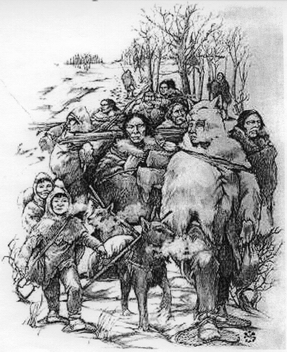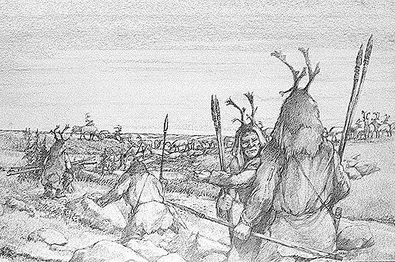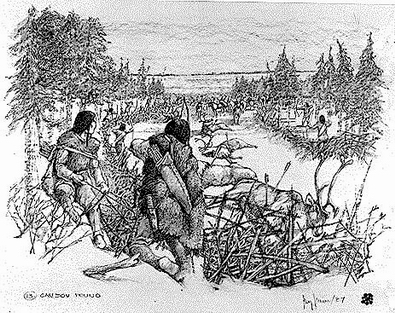Adaptation for Survival
 Most Canadians have no knowledge of our sub-Arctic aboriginal cultures. These were nomadic hunter societies, compelled to intersect swift-moving herds of caribou over broad ranges, and left few signs of their presence. And yet these uncovered and surface remains have become keys to our understanding of how they survived this harsh environment.
Most Canadians have no knowledge of our sub-Arctic aboriginal cultures. These were nomadic hunter societies, compelled to intersect swift-moving herds of caribou over broad ranges, and left few signs of their presence. And yet these uncovered and surface remains have become keys to our understanding of how they survived this harsh environment.
Let us look first at their Chronology, through 8000 years of adaption to biophysical change.
Barrenlands Cultures
 Select from any era on our Chart a description of Barrenlands culture. Anecdotal records are few, and only begin with the arrival of European explorers and fur-traders. With the introduction of metal for tools and weapons, hunting methods changed radically, but did not initially displace the caribou’s importance to human survival. The artist drawings on this page are broad representations of these ancestral cultures, based upon the range and features of artifacts we can date to their presence.
Select from any era on our Chart a description of Barrenlands culture. Anecdotal records are few, and only begin with the arrival of European explorers and fur-traders. With the introduction of metal for tools and weapons, hunting methods changed radically, but did not initially displace the caribou’s importance to human survival. The artist drawings on this page are broad representations of these ancestral cultures, based upon the range and features of artifacts we can date to their presence.
| Culture | Years Ago |
| Dene Chipewyan | Present-200 |
| Late Taltheilei | 200-1300 |
| Middle Taltheilei | 1300-1800 |
| Early Taltheilei | 1800-2450 |
| Earliest Taltheilei | 2450-2600 |
| Pre-Dorset ASTt | 2650-3540 |
| Shield Archaic | 3500-6500 |
| Northern Plano | 7000-8000 |
| For a Description of each Culture, select its Name | |
Ethnographic Observations
Band-herd Affiliation and Herd Following
Human Seasonal Nutrition and Birth Spacing
Read Samuel Hearne’s account of a “deer pound”
Images are courtesy of Historic Resources Branch, Manitoba Culture, Heritage and Tourism; artist: Larry Jamieson